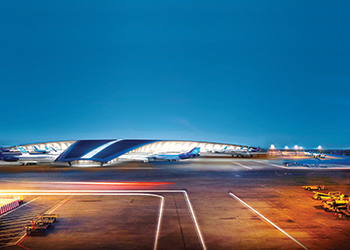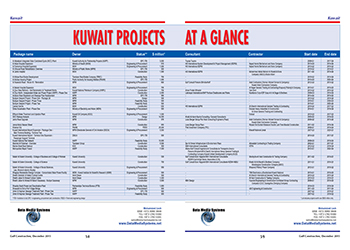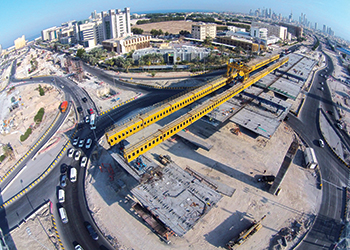

The Jamal Abdul Nasser Street Development is yet another mega project being undertaken by the Ministry of Public Works.
The Jamal Abdul Nasser Street Development Project is more than halfway through, standing at 67.5 per cent complete and project works advancing concurrently on construction sites along the project line as well as offsite in the project’s segment precast yard.
The strategic project, costing KD242.4 million ($798 million), is part of Kuwait Ministry of Public Works’ (MPW) ongoing plans in the country to enhance the existing infrastructure and transportation network.
Speaking to Gulf Construction, Ahmad Al Hassan, assistant undersecretary of the Roads Engineering Affairs in the MPW, states: “The project aims to transform the existing Jamal Abdul Nasser Street into an internationally standardised multi-levelled expressway extending from the Jahra Gate (Jahra Gate Roundabout-Sheraton) to Grenada area in the western region of Kuwait. The masterplan includes a multi-levelled elevated highway alongside the upgrading and reconstruction of the existing service roads to provide additional traffic lanes with enhanced new or relocated utilities infrastructure. A joint venture of Louis Berger and Pace has been assigned to undertake the design and construction supervision of the project.”
 |
The project’s calibre is measured by the advanced and large-scale structural propositions employed, ranking it as one of the largest of its kind in the world. |
The contractor is a joint venture of Rizzani De Eccher (Italy), Obrascon Huarte Lain (Spain), Trevi (Italy) and Boodai Construction (Kuwait). Work on the project commenced in May 2011 and is contractually scheduled for completion in October 2016.
Mahmoud Haji Ramadan, project engineer, MPW – Roads Engineering Sector (Motorways department), says: “The upgraded Jamal Abdul Nasser highway will serve as an efficient transport infrastructure for the road’s existing adjacent establishments, which include educational facilities such as Kuwait University and University of Applied Sciences; medical, such as the Shuweikh Medical Zone; governmental, such as the Ministry of Defence; trade and others.
The project is interconnected within a network of newly developed highways, which include the Jahra Highway, Jaber Causeway and Doha link. These roads serve the city and provide the main access to newly developed projects such as Silk City and Mubarak Al Kabeer Seaport.
The Jamal Abdul Nasser project consists of five phases, work on which is being undertaken simultaneously. Phase One starts from Airport Road Roundabout to First Ring Road (Al Salam Palace); Phase Two is from Sabah Hospital Road Roundabout to Grenada area toward Jahra City; Phase Three extends from Al Razi Hospital Interchange to Ghazali Roundabout; Phase Four extends from Ghazali Roundabout to Airport Road Roundabout; and Phase Five connects Ghazali Interchange with Jamal Abdul Nasser.
Ramadan says work was phased for several reasons. “Phasing traffic detours facilitates traffic flow in congested areas; relocation of services was in phases as per technical specifications; there was a need to complete the first phase at an early stage; and the nature of segmental erection requires works to commence from one end of the project and to proceed in a linear sequence.”
 |
The project’s calibre is measured by the advanced and large-scale structural propositions employed, ranking it as one of the largest of its kind in the world. |
Project overview
Dr John Faulkner, project director, Pace/Louis Berger, says the project, both in its design and construction, is an engineering marvel.
He says: “The project’s calibre is measured by the advanced and large-scaled structural propositions employed, ranking it as one of the largest multilevel road projects in the world. Attempting this in such a busy metropolis like Kuwait City, along with the fact that it involves the upgrading of an existing busy road, requires very intricate methods of construction; one that does not impede or disrupt the traffic flow or perturb public environment dynamics.”
Commenting on the methodology used during construction, Tarek Shuaib, managing partner, Pace, says for precast segmental erection of the bridges, a technique called ‘segmental span by span’ is being used.
“This technique involves completion of one deck span of segments after another, where bridge segments of one span are lifted altogether, stressed and then epoxy glued together to form a complete deck.”
Shuaib says the advantages of span-by-span erection include speedier erection of bridge segments, easy geometry control and employing a smaller crew size for operation. Launching gantries have been imported for the project and two have been assembled and in use so far.
Jamal Abdul Nasser Street will have 8.33 km of twin carriageway segmental viaducts, 6.89 km of single carriageway segmental viaduct, 118.1 km of bored cast in-situ piling, 348,946 sq m of elevated deck area, 7,613 precast segments and eight pedestrian overpasses.
The project also includes a 716-m-long section of depressed road which will have two roundabout bridges. New at-grade service roads, generally of twin three-lane configuration, will be located either alongside or underneath the elevated mainline roadway. A total of four interchanges and nine roundabouts will be constructed. There will be 10.07 km of mainline six- to eight-lane highway, 1.04 km of four to six-lane length roads, 11.01 km of ramps for interchanges, and 11.61 km of six-lane service roads
 |
Jamal Abdul Nasser Road project ... being built at a cost of $798 million. |
In addition to transforming the Jamal Abdul Nasser into a unified highway, the project also includes the renovation of a number of utilities and drainage structures along the length of the project route that require relocation, protection, and refurbishment. Renovation works include relocation of water lines and sewage system, relocation of telephone services, gas lines and voltage cables in addition to other preservation works. As such there will be 773 m of concrete box culverts for water, 41,245 m of water lines, 10,326 m of sewage lines, 152 manholes, 300 m of gas lines, 61,883 m high-tension electrical cables, and 18,355 m of telephone lines.
A purpose-built precast facility has been established where work continues around the clock to manufacture precast concrete segments for the elevated viaduct, which is approximately 7.2 km long and has six to eight lanes with access ramps that are one or two lanes wide. The link road viaducts, are also of precast segmental construction and vary in width from four to six lanes.
The fully utilised precast yard has been set up on a remote area of land located in Doha area with a total surface area of 130,000 sq m. It’s equipped with large-scale pre-cast machinery, such as mould production frames, heavy gantries, water tanks, storage and curing chambers, staff offices and a concrete batching plant.
In the yard’s steel reinforcement cutting zone, steel bars are cut and shaped to form segment frame reinforcement. A total of 11 overhead electrically operated cranes lift the frameworks to the segment mould machines in order to complete the casting and pre-stressing process. A total of four gantry cranes weighing more than 100 tonnes have been set up and are functional in the yard which move the complete segments to curing then storage for site use.
Dr Faulkner says the precast yard provides ample space for work and a suitable environment which guarantees the quality of the segments with regard to consistency, meeting strength requirements. Other advantages include easy geometry control and guaranteeing an elevated speed on construction and quality control in addition to very limited or no public disturbance.
 |
Jamal Abdul Nasser Road project ... being built at a cost of $798 million. |
Project progress
According to the latest updates, the Jamal Abdul Nasser Street Development Project is 67.5 per cent complete. The structural works, for the construction of elevated highways, are in steady progress and stand 50 per cent complete. The mainline works have reached 75 per cent completion and ramps are 30 per cent complete. This includes the installation of edge and median barriers.
In addition, 75 per cent of structural works for underpass construction is also complete. Moreover, the on-going production of precast segments for the elevated mainline is currently at 95 per cent of progress, with a 10-12 segments produced per day. As for detours and relocation and protection of utilities, approximately 75 per cent of on-going works have been completion so far alongside Jamal Abdul Nasser’s original road.
Commenting on the project challenges, Al Hassan says: “This will be the first project in Kuwait to illustrate the stakeholders’ ability to deliver large-scale global projects. This comes by managing the risks and challenges to a successful conclusion.”
Ramadan adds: “The nature of such projects requires continuous co-ordination with concerned authorities. The project management also requires a set of internal procedures for obtaining necessary approvals from each authority concerned. This is important so as to ensure the project is completed on time. Frequent follow-ups are made with all parties involved to ensure the most efficient document control management.”
One such challenge is the construction of structural elements, in addition to heavy utility works, in restricted work areas and in coordination with different parties.
 |
Precast yard ... set up in a remote place in the Doha area. |
Other challenges include the project being in a fully populated and busy urban area with work area limitations and thus requiring intricate and faultless planning to avoid logistical issues. There is also heavy traffic on the road due to the presence of important services like hospitals, universities and institutes. These issues have been addressed through world-class detours that wholly serve the traffic and are inclusive of all standards of any existing road, such as light posts, bus stops, road markings, safety lanes and barriers and traffic signals.
Separately, equipment, machinery and materials imported from abroad require early planning and coordination with several parties in order to meet the construction schedules. Meanwhile, extreme weather conditions are additional factors that affect concrete casting operations and on-site productivity.
All stakeholders are taking extra steps to ensure environmental and safety regulations. Dr Faulkner says construction jobs on site must be strictly executed within environmental standards and regulations placed and developed periodically by the Environmental Public Authority.
Shuaib confirms this saying that the project requires a certified specialist with the commission to raise a monthly report to the EPA on all environmental impacts caused by the project.
“The report includes a monitoring log of readings and occurrences in all project areas taken through daily visits and field measurements. The report determines the air quality, noise readings, quality of groundwater, water sanitation, solid waste and liquid waste, thereby confirming the implementation requirements under the contract,” he adds.
The existing planting and greenery lost during implementation will be compensated for with the final landscaping of the project which will cover more than 300,000 sq m when the project is complete.





















_0001.jpg)


.jpg)
















.jpg)








.jpg)




